Vancouver’s art scene is about to get a bold new addition with the opening of Medias Res Gallery, a vibrant new space dedicated to showcasing Canadian and international artists. The inaugural exhibition, Henna Night II / Shabe Kheena II, marks a milestone moment for celebrated Afghan-Canadian artist Hangama Amiri, as she brings her intricate textile work to British Columbia for the first time. Curated by Maryam Babaei, the show explores themes of home, memory, and cultural traditions through richly detailed fabric compositions.
We caught up with Amiri and Babaei to discuss the inspiration behind the exhibition, the importance of creating spaces for diverse artistic voices, and how Medias Res Gallery will shape Vancouver’s creative landscape. —Noa Nichol
Hangama Amiri (Artist)
Your work primarily explores themes of home, gender, and cultural memory through textiles. What drew you to this medium, and how does it help you tell these stories?
Though I first trained as a painter, my creative process led me to textiles over time as I ponder the relationship between my experience and my medium. Fabric has always been a part of my world—growing up, I was surrounded by the presence of textiles, from watching women sew in the bazaar and at home to playing with handmade dolls alongside my cousin. My uncle’s fabric shop was another space where I became attuned to the textures, colors, and movement of cloth. For me, textiles carry memory; they hold the warmth of home, the traces of daily life, and the labor of women whose work is often overlooked. By layering materials, stitching by hand, and combining different fabrics, I explore ideas of migration, belonging, and gender, drawing from both personal experiences and shared histories.
Henna Night II / Shabe Kheena II reflects intimate pre-wedding traditions. What inspired you to focus on this particular ritual, and what do you hope audiences take away from it?
When I depict scenes from traditional celebrations, I aim to capture the collective joy within the diasporic community, particularly among women. These gatherings are more than rituals—they are spaces of kinship, abundance, and care, where immigrant women create a sense of home together, regardless of the external circumstances. Through my work, I want to highlight the bonds of support and resilience that emerge in these moments, emphasizing the ways in which women sustain and uplift one another across generations and geographies.
Your work blends personal narratives with broader social and political themes. How do your Afghan-Canadian identity and experiences influence your artistic approach?
My experience as an immigrant woman, growing up among other immigrant women, has shaped my perspective on women’s labor, intelligence, resilience, and care—qualities that are often overlooked in a world dominated by masculine narratives. This is why my artistic practice centers on the presence of women—their entrepreneurship, their roles as mothers, their desires, and their expressions of beauty. I often take a female-first perspective in storytelling, making space for the lived experiences of women. Themes of displacement, memory, identity, and gender are deeply embedded in my work, all rooted in my own diasporic journey. By weaving my personal story into my practice, I hope to encourage others in the diaspora to embrace their own sense of belonging and the hybrid identity.
You’ve exhibited internationally, from Canada to Germany to the UAE. How does showcasing your work in different cultural contexts shape the way your art is received?
I appreciate receiving feedback from different cultural perspectives. Since my work navigates fluid cultural spaces and hybrid identities, I find curatorial interpretations and audience responses particularly fascinating. They reveal the pressing issues each culture is grappling with and highlight the voices that are most needed in different contexts. These varied perspectives enrich my understanding of how my work resonates across borders, reinforcing the dynamic nature of identity and artistic discourse.
As this is your first solo exhibition in British Columbia, what does this moment mean to you personally and professionally?
I’m truly excited for this opportunity to connect with communities in British Columbia. We’re planning public programming alongside the exhibition, and I’m looking forward to sharing my thoughts and experiences in person. Engaging in direct conversations and exchanges is something I deeply value, and I can’t wait to meet and interact with people face-to-face during the show!
Maryam Babaei (Curator)
What made Hangama Amiri’s work the ideal choice for the inaugural exhibition at Medias Res Gallery?
Hangama Amiri’s work has a remarkably impactful way of weaving together the personal and the universal. Her intricate tapestries reflect culturally specific and deeply personal experiences, yet they feel familiar and universally resonant, thanks in part to her meditative and wonderfully vulnerable approach to building visual narratives and the familiarity and tactility of her medium. The nostalgia, longing, defiance, hope, and joy that these pieces evoke transcend cultural and geographic boundaries. Amiri’s work exemplifies the capacity of art to overcome cultural divides and generate understanding, and this potential for meaningful intercultural communication is what motivates our work.
I should note that we’ve been following Hangama’s career for a few years now, and we’d be thrilled to work with her at any point in time. We were fortunate that the opportunity arose in time for Medias Res’s first exhibition.
The Vancouver art scene is constantly evolving. How do you see Medias Res Gallery contributing to the city’s artistic landscape, particularly for underrepresented artists?
VIVA Alliance‘s decision to open Medias Res Gallery was inspired by the overwhelming response to our initial exhibitions at the Roundhouse Community Arts and Recreation Centre. In a short time, we were approached with multiple proposals and programming ideas, and we found that the lack of an accessible and permanent space was a barrier. While Vancouver enjoys a vibrant and rapidly evolving art scene, it became clear to us that there is need for more accessible art spaces for diverse communities, particularly for artists new to the city. Medias Res is intended to serve as an inclusive platform for artists to share their work and engage with the broader community through exhibitions and a range of other cultural activities.
VIVA Alliance is deeply rooted in fostering intercultural dialogue. How does this exhibition align with that mission?
Referring to my response to question 1, Hangama Amiri is an accomplished artist whose work perfectly exemplifies the capacity of art to transcend cultural boundaries and generate intercultural understanding.
What curatorial considerations went into presenting Henna Night II / Shabe Kheena II in this space? Were there specific design or thematic elements you wanted to highlight?
We are still in the midst of planning, but our focus so far has been on minimizing interference between the works and their audience. This exhibition seeks to amplify and celebrate feminine narratives that are often overlooked outside domestic contexts. We are collaborating closely with Hangama to make sure that these works have a culturally appropriate and sufficiently intimate setting where these works can communicate with their audience on their own terms.
If visitors could take away one key message from this exhibition, what would you want it to be?
Like all successful art, Henna Night II / Shabe Kheena II artfully resists being simplified into a single message. I simply hope visitors walk away intrigued and motivated to learn more about the rituals and experiences depicted in this exhibition with an enhanced lens for appreciating the shared struggles, desires, joys, and anxieties that connect us across cultural, geographic, and gender divides. I also hope they are as dazzled by the visual richness of these tapestries as I am.
Henna Night II / Shabe Kheena II artwork captions and credits
1. Hangama Amiri, Her Dressing Table, 2022, chiffon, muslin, cotton, polyester, silk, inkjet print on chiffon, iridescent paper, denim, suede, and found fabric. 67.5” x 58”, Photo by Chris Gardner, Courtesy of the Artist and Cooper Cole, Toronto.
2. Hangama Amiri, Henna Painting, 2022, chiffon, muslin, cotton, polyester, silk, vinyl, and acrylic paint on fabric. 31″ X 24.5″, Photo by Chris Gardner, Courtesy of the artist and the Collection of Rajiv Kannan Menon.
3. Hangama Amiri, Instant Henna (2023), muslin, cotton, chiffon, polyester, and denim. 36″ X 28″, Photo by Chris Gardner, Courtesy of the artist and Cooper Cole, Toronto.
Henna Night/Shabe Kheena installation photo captions
1–4. Photo: Installation view of Henna Night/Shabe Kheena at the David B. Smith Gallery (Denver, CO). Courtesy of the artist and Cooper Cole, Toronto.
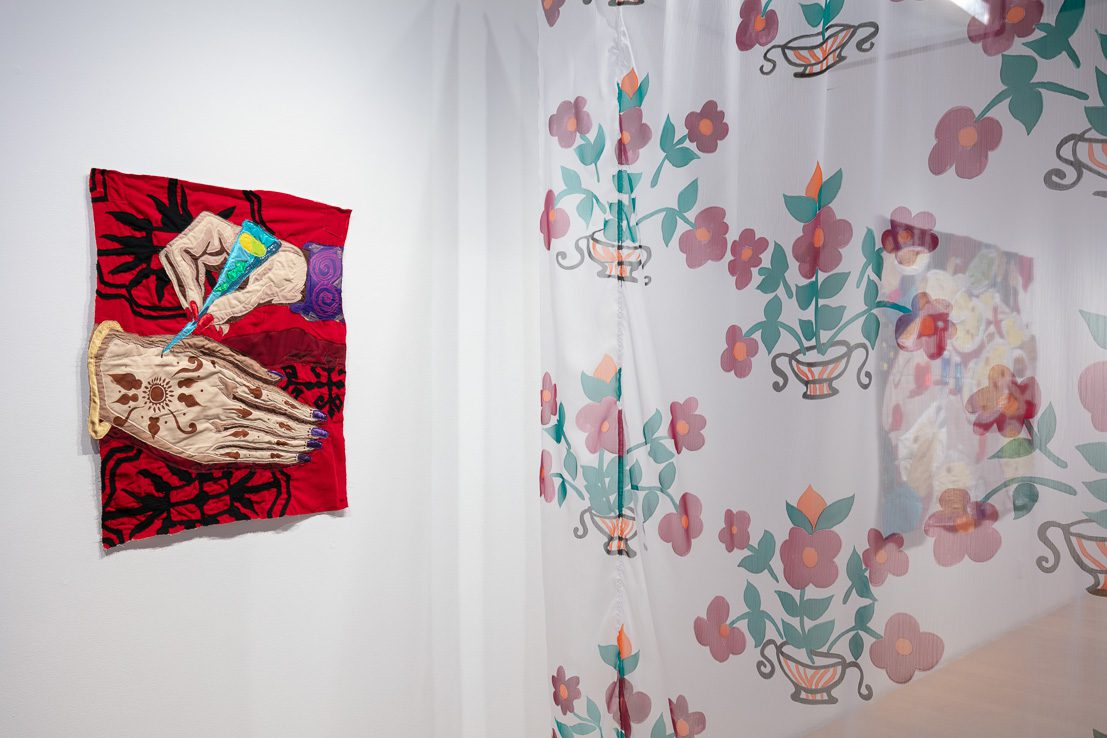
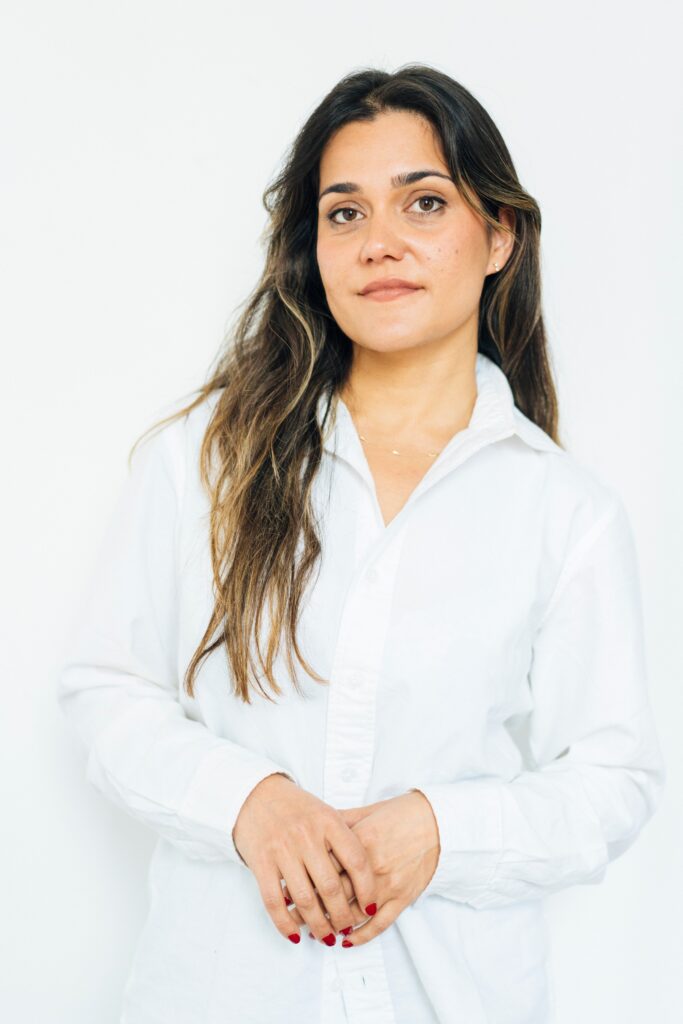
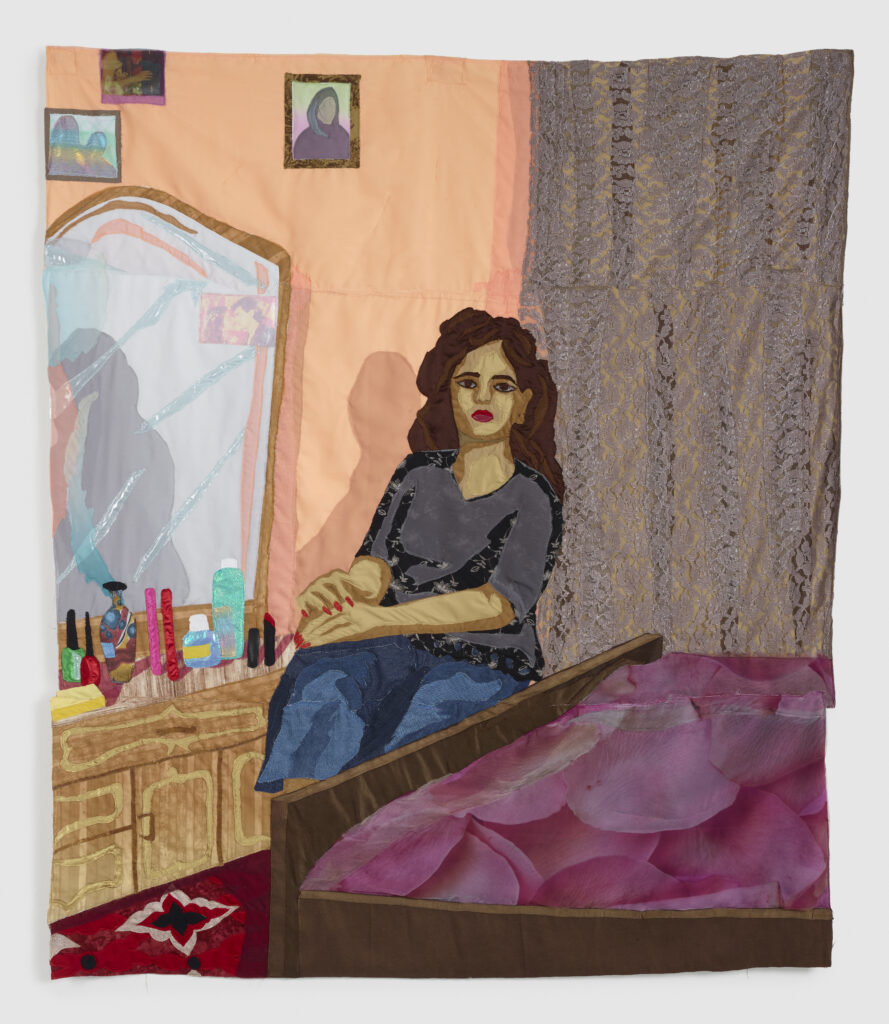
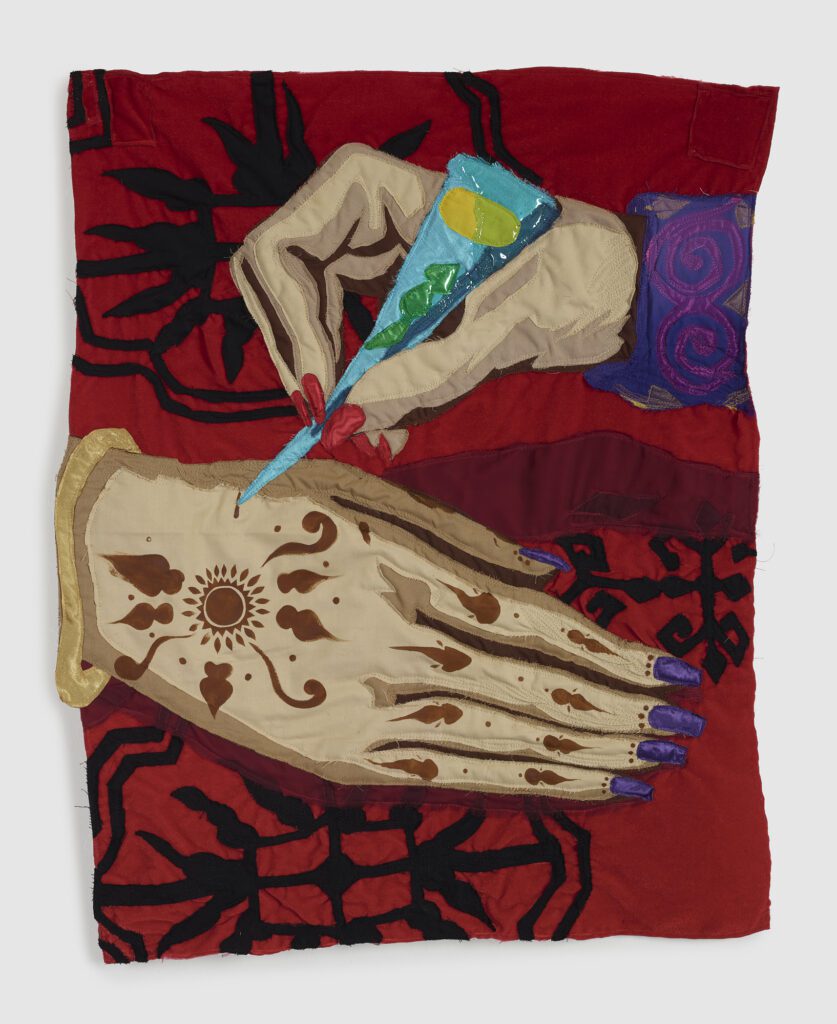

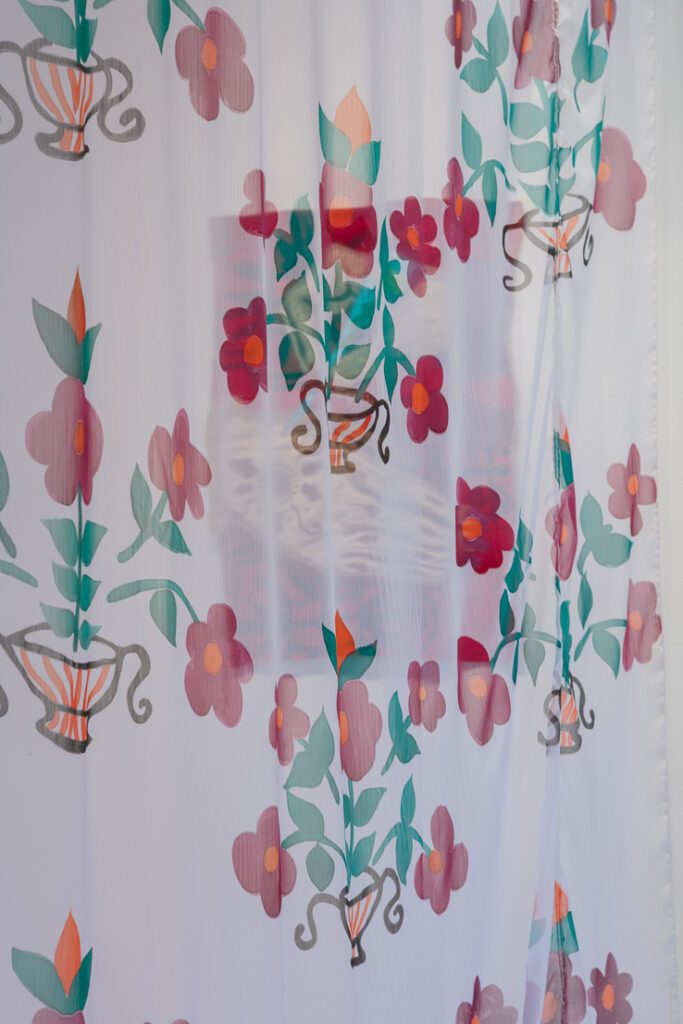
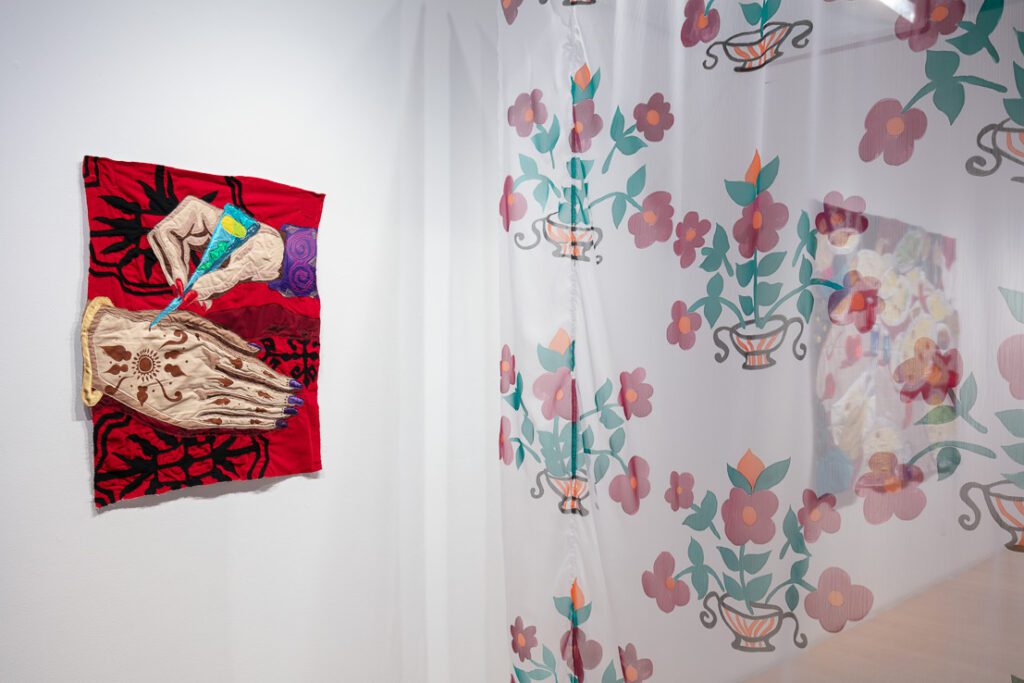
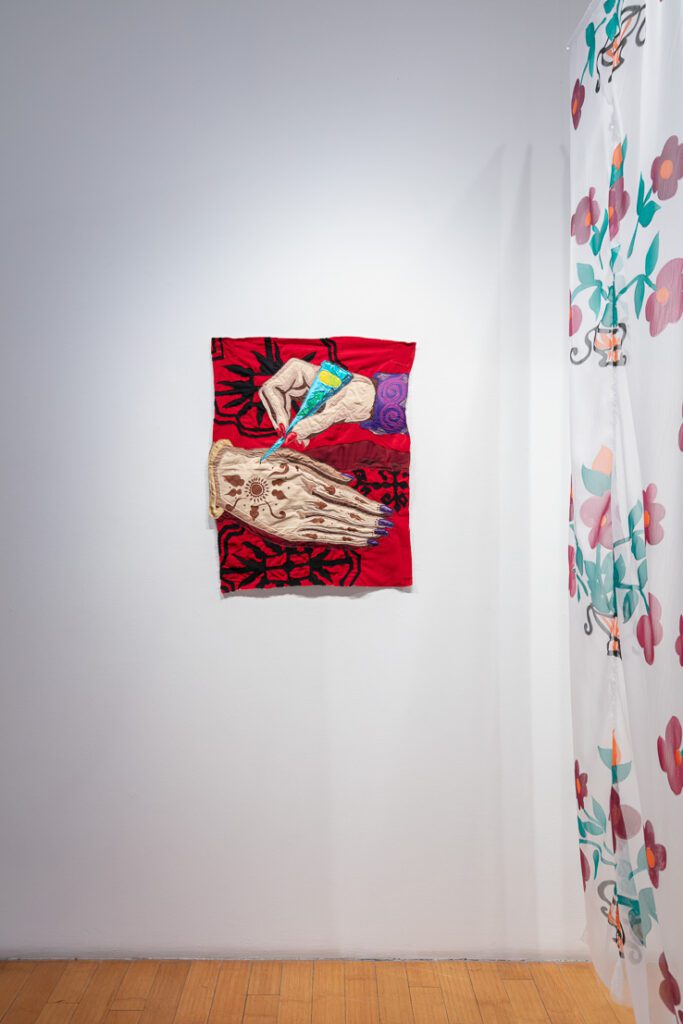
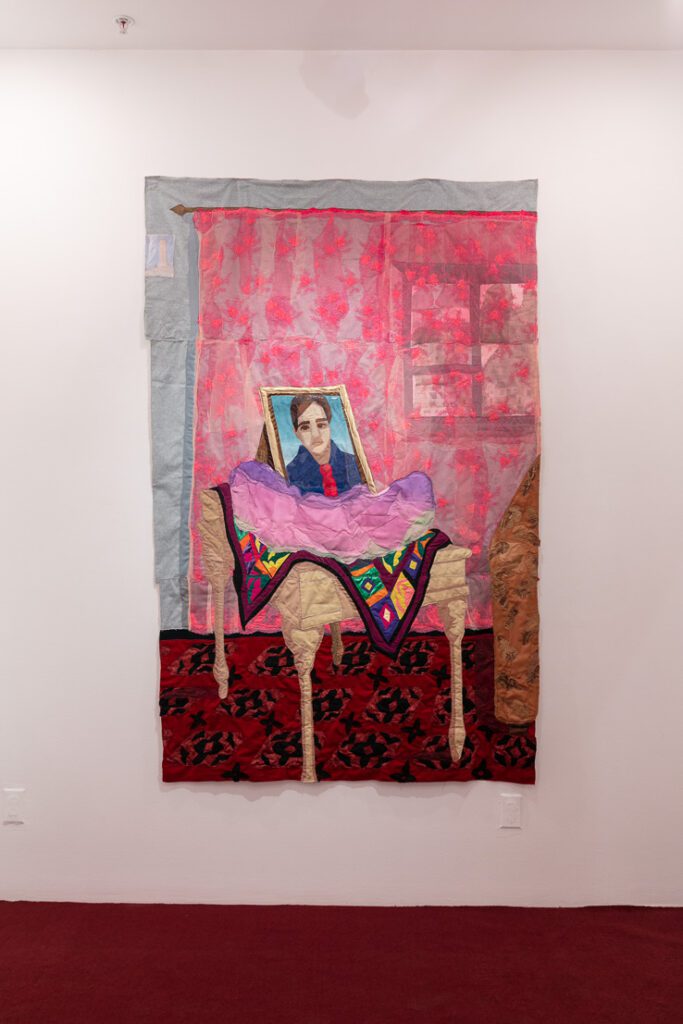
Be the first to comment